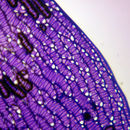Comprehensive Description
provided by North American Flora
Sphagnum squarrosum Crome, Samml. Dents Laubm. 24. 1803.
Plants generally tall and very robust, bright-green or sometimes yellowish. Woodcylinder green to reddish-brown; cortical cells of the stem in 2-3 layers, of irregular size and shape, with thin walls, the outer cells narrowly quadrilateral, much longer than broad, without fibrils or pores: stem-leaves large, long ovate-lingulate, slightly concave, the apex weakly lacerate-fimbriate, passing into a suggestion of a hyaline border and this into an indistinct border of narrow cells extending to the base; hyaline cells in the apical portion rhomboidal, short, not more than 2-3 times as long as wide, in basal side-regions of the same length but narrow^er, mostly undivided and without fibrils, the membrane on the outer surface almost completely resorbed, on the inner surface the membrane-gaps confined to cells of the immediate apex, the membrane otherwise entire, frequently with longitudinal membrane-pleats: branches often very long, in fascicles of 5, 2 spreading, their cortical cells in a single or double layer, without fibrils, the retort-cells slightly differentiated with inconspicuous neck: branch-leaves strongly squarrose from the center, sometimes spreading or nearly imbricate, large, ovatehastate, broadening rapidly from the base, then suddenly contracting to an acute, involute, toothed apex, the border entire, of 2-3 rows of long narrow cells; hyaline cells strongly fibrillose throughout, narrowly rhomboidal, 4—8 times as long as wide, shorter toward the ai>ex and much broader in the middle side-regions, on the inner surface with rather numerous round pores in the ends of the cells and near the commissures, 4-10 per cell, except in the middle basal portion where they are lacking, most numerous and largest in large cells of the middle side-regions, on the outer surface less numerous, in the ends and corners of the cells, generally 1-3 per cell, except in the middle basal portion where they are large and numerous in a single or double row, sometimes 10 or more per cell, with pseudopores also in apical cells; chlorophyl-cells in section triangular with the base exposed on the outer surface or trapezoidal with a narrow exposure also on the inner surface; inner walls of the hyaline cells where overlying the chlorophyl-cells often strongly papillose; hyaline cells convex on both surfaces, on the outer only slightly, one sixth or one fifth, on the inner rather more, one fourth or one third of the diameter of the cell.
Monoicous. Antheridial catkins conspicuous; antheridial leaves often deeply pigmented, brown, spreading, ovate, strongly involute, smaller than the normal branch-leaves, the fibrils in cells of basal region weak or lacking. Fruiting branches erect, long; perichaetial leaves long-lingulate, strongly involute, the apex truncate or retuse, fimbriate, their texture as in the stem-leaves; hyaline cells on the outer surface with large membrane-gaps, on the inner surface entire with longitudinal membrane-pleats: capsule brown: spores brownish-yellow, 20-25 m in diameter, papillose.
Type locality: Europe.
Distribution: Greenland and Labrador southward to New Jersey; Pennsylvania; Ohio; Michigan: Wisconsin; Minnesota ; Colorado; California northward to Alaska and adjacent islands; also in Europe and Asia.
- bibliographic citation
- Albert LeRoy Andrews, Elizabeth Gertrude Britton, Julia Titus Emerson. 1961. SPHAGNALES-BRYALES; SPHAGNACEAE; ANDREAEACEAE, ARCHIDIACEAE, BRUCHIACEAE, DITRICHACEAE, BRYOXIPHIACEAE, SELIGERIACEAE. North American flora. vol 15(1). New York Botanical Garden, New York, NY

